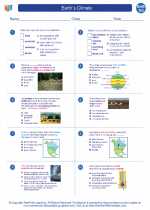Rivers
Rivers are natural watercourses that flow towards an ocean, sea, lake or another river. They are vital to the Earth's ecosystem, providing water for drinking, irrigation, transportation, and habitat for numerous species. Understanding the formation, characteristics, and functions of rivers is an important aspect of earth science.
Formation of Rivers
Rivers are formed through the process of erosion, transportation, and deposition of sediment. The main factors that contribute to the formation of rivers include precipitation, elevation, and the geological characteristics of the land. When rain falls on the land, it collects in depressions and starts to flow downhill, creating small channels. Over time, these channels deepen and widen, forming streams that eventually merge to create a river.
Characteristics of Rivers
Rivers have several key characteristics, including their source, mouth, tributaries, and watershed. The source of a river is the point where it begins, often in high elevation areas such as mountains or hills. The mouth of a river is where it empties into a larger body of water, such as an ocean or lake. Tributaries are smaller streams that flow into the main river, adding to its volume. The watershed of a river is the area of land that drains into the river and its tributaries.
Functions of Rivers
Rivers play a crucial role in the environment and human society. They transport sediments and nutrients, shaping the landscape and providing fertile soil for agriculture. Rivers also support diverse ecosystems, serving as habitats for fish, plants, and other wildlife. Additionally, rivers have been historically important for trade, transportation, and as a source of renewable energy through hydropower.
Study Guide
- What are the main factors that contribute to the formation of rivers?
- Explain the significance of the watershed in the context of river systems.
- Discuss the role of rivers in supporting ecological diversity.
- How have rivers historically contributed to human civilization and development?
- Describe the process by which rivers transport sediments and shape the landscape.
Understanding the formation, characteristics, and functions of rivers is essential in comprehending the Earth's dynamic processes and the interconnectedness of natural systems.
[Rivers] Related Worksheets and Study Guides:
.◂Earth Science Worksheets and Study Guides High School. Earth`s Climate

 Worksheet/Answer key
Worksheet/Answer key
 Worksheet/Answer key
Worksheet/Answer key
 Vocabulary/Answer key
Vocabulary/Answer key
 Vocabulary/Answer key
Vocabulary/Answer key
 Vocabulary/Answer key
Vocabulary/Answer key
